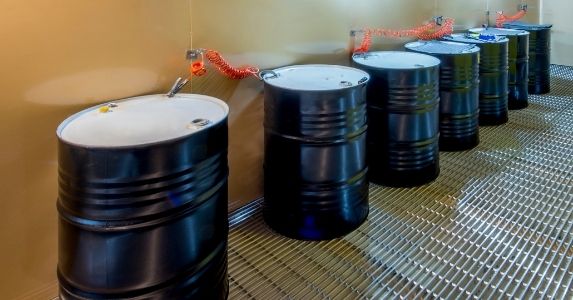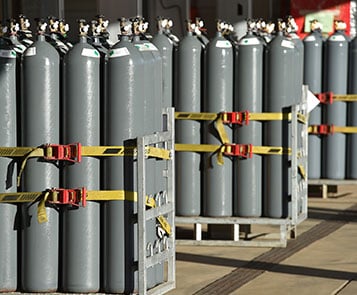MAQs: How Your Chemical Storage Needs May Impact Real Estate Decisions
Maximum allowable quantity (MAQ) regulations often dictate real estate management decisions—especially during lab moves, buildouts, and openings. MAQ noncompliance can mean costly reorientation, citations, or even shutdown—not to mention the organizational and environmental safety implications. As such, it’s crucial to review your own MAQ requirements and compare those to any potential real estate consideration to ensure you will maintain compliance. Failure to factor in MAQs when laying out or configuring facilities can:
- Expose a lab or production operation to potential chemical or hazmat incidents
- Cause what would have been avoidable citations or fines from inspectors
- Potentially result in costly operational shutdowns and loss of time and resources
MAQs: Crucial For Safety
MAQs are the prescribed limits that dictate the types, configurations, and amounts of hazardous materials—chemicals and waste—that can safely be stored on a specific worksite. They are formulated to mitigate the risks of hazardous materials and consider a wide array of specific scenarios that may increase potential dangers. Limits will vary based on operational needs, waste generator status, facility size and layout, and more.
Technical definitions, both at the state and local level, are determined primarily by the National Fire Protection Association (NFPA)—but enforcement varies greatly, often depending on the municipality and other local factors. The essential underlying NFPA framework, however, remains consistent nationwide.
Limits will vary based on but not limited to:
- Specific material hazards for both chemicals and wastes that are generated
- Facility use classification and design requirements
- Lab unit maximum quantities, if applicable
- Local jurisdiction (municipal, state, etc.)
- Operational needs
- Waste generator status
- Facility size and layout, including the:
- Characteristics of onsite storage cabinets and storage rooms
- Specific fire prevention measures
- Control areas
True MAQ compliance demands careful calculation and advanced regulatory review.
Stumbling and Scrambling: MAQ Real Estate Violations
Life sciences, healthcare, pharmaceuticals, and other related industry managers likely understand MAQ compliance in a general sense. They may not realize, however, how complex and intricate the relevant rules are—and how these regulations may dictate something as routine as real estate management considerations.
Which then means that often these same environmental, health, and safety (EHS) managers only realize that their facility’s layout and storage practices are noncompliant when it is too late—leaving them to scramble to remediate any MAQ violations. Sometimes, full compliance is not even possible at their chosen location because of their specific operations. This can eat up time and effort as well as cause extended operational challenges while management panics trying to decide what to do.
Because of the innate dangers that arise when changing lab location and to avoid these operational stumbling blocks, MAQ rules deserve special scrutiny during:
- Lab relocations or commissioning
- Facility expansions and renovations
- Building upgrades
- Similar real estate events
Fortunately, there are well-defined rules and principles for management of a physical site or facility space, which can be used during real estate capacity and layout planning. This will enable proactive arrangement of workplaces so that MAQ noncompliance—and the safety risks that come with it—is never a risk.
MAQs and Real Estate Management
For true MAQ compliance and operational safety, it’s essential to compare your onsite hazardous materials storage with the floor level allotments. To do so, you need to be familiar with the following concepts and classifications:
Control areas: Understanding what a control area is—and how to manage it—is essential. This term describes any space in a building, either indoors or outdoors, where hazardous materials will be stored, used, etc. The control area’s type, size, and more will dictate the types and quantities of hazardous materials that can be stored and used within it.
A single control area can comprise a:
- Complete building
- Floor
- Room
- Contiguous room suite
Use classification: Fire prevention engineers and architects determine a building’s use classification as the facility is being constructed or renovated. The classification will be dependent upon facility design, construction materials, and relevant fire codes set forth by the NFPA. MAQ limits are significantly influenced by the specific use classification.
Lab unit maximum quantities: In addition to general MAQ rules, laboratories may also need to conform to pre-defined lab unit maximum quantities. These may further restrict the quantity of hazardous materials stored in any given laboratory space.
MAQ floor-level guidelines: Although often overlooked, the floor level where hazardous materials will be located is a crucial factor in MAQ compliance. Higher floors in a building bring greater safety risks; evacuation from upper levels takes longer and any spills will flow downward. The loftier the workplace, the greatest potential damage to not only the individual space but to the overall facility space below it. A fourth-floor lab will present increased jeopardy versus a third-floor one, and so the fourth floor has lower MAQs than the first through third floors. This consideration necessitates collaboration and clear communication between neighboring labs and organizations within the same building.
Key MAQ Considerations for New Workplaces
It’s crucial to consider MAQ regulations as soon as possible when moving into a new space, so you can understand how your building configuration can best (and most compliantly) support your hazardous chemical and waste storage system plans and infrastructure.
The further ahead of the relocation or expansion MAQ guidelines are considered, the less cost and headache it will be to remain safe and compliant. A larger headway to review these rules will allow ample time to make all necessary construction, planning, and design arrangements—and enable you to make real estate decisions that work for your operations.
Among the major initial tasks for proper MAQ real estate compliance:
Assess your storage needs up-front: Where will chemicals and waste be stored at this new or upgraded facility? This is a key yet sometimes complex consideration, with many different facets. If your lab is on a higher floor, for example, that may severely limit your ability to store hazardous chemicals and waste in easily accessible areas. Not taking these rigid MAQ limits into account up-front can mean future operational disruption—and perhaps even lead to excess storage costs.
Compare MAQ limits: Ensure that the MAQ limits across the floors of your new space align with your needs. If they don’t, consider finding a new location that allows you to remain compliant. Don’t forget the quantity of hazardous substances used in addition to the amount stored!
Consider facility upgrades: After performing assessments of operations and storage requirements, you may find a space wanting. Your plan requirements and facility’s current use classification may exceed the MAQ limits. It may be possible to increase these limits by building out or upgrading your facility plans, such as through enhanced fire suppression systems and improved ventilation.
Devise a communications plan: Map out all your MAQs and control areas within your planned workspace, then create a communications system with internal staff as well as fellow tenants on your floor or in the same building. Know what the other tenants are doing—they may have hazardous materials on-hand too. Honest data sharing will ensure no one organization in the facility exceeds legally allowable limits—and keeps everyone safe.
Understanding these risks and how your building configuration could impact your hazardous chemical and waste storage will help ensure safety and compliance—and guide you in making real estate decisions that work best for your operations.
Turn to the Pros for MAQ Support
MAQ compliance can be a confusing and tedious puzzle given the varied materials, facility-specific considerations, emergency response rules, and floor levels—and one that might require an expert to solve. On top of this, lab moves are hectic, expensive, and complicated enough without factoring in MAQ real estate challenges. Your internal team members may be incapable of addressing all these issues and making the proper calculations.
To avoid the risk, consider turning to a partner that is experienced in MAQ compliance. Triumvirate Environmental is such a partner. We can take the MAQ compliance burden off your shoulders; our experienced team can help with your MAQ risk assessment and advise your business on optimal move-in decisions. Contact us today to learn more about how we can assist you.







